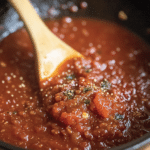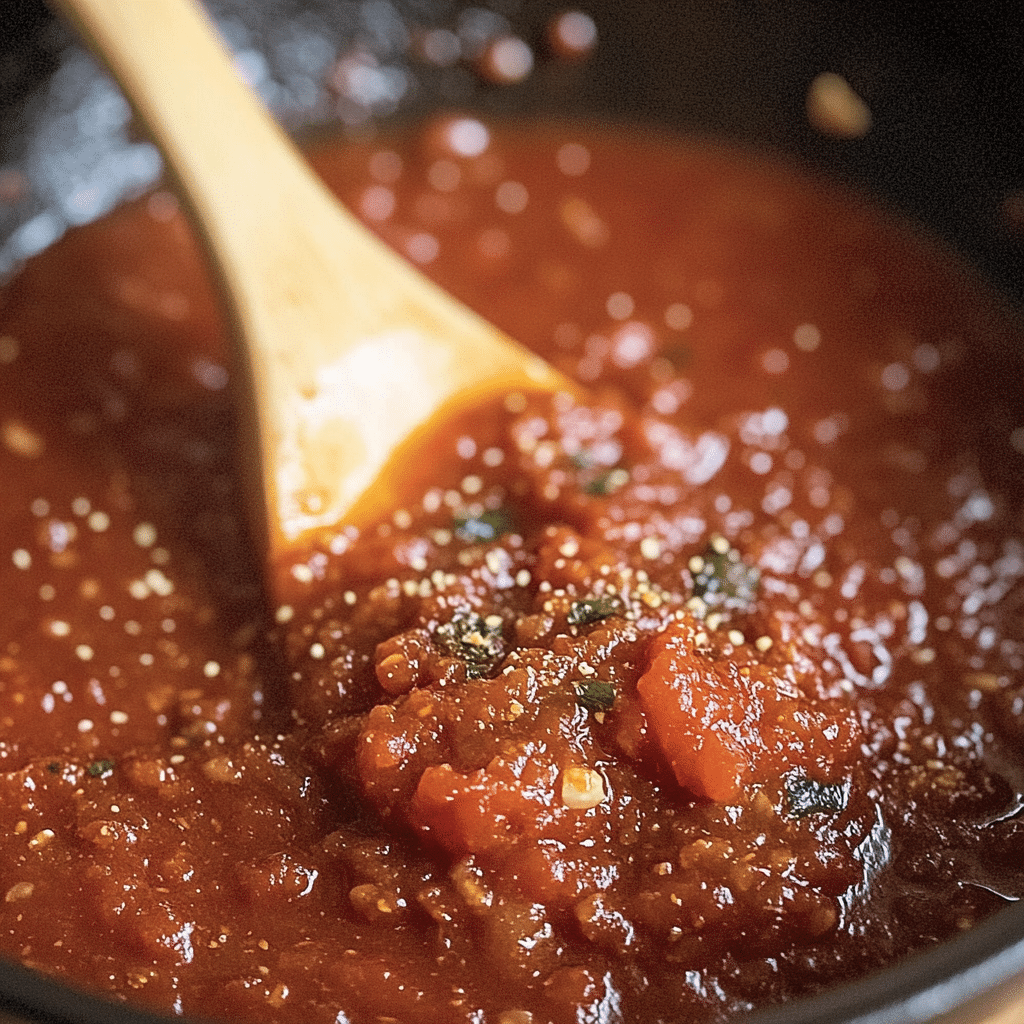If you’re looking for a rich, flavorful, and easy-to-make spaghetti sauce, homemade is the way to go! Unlike store-bought sauces, homemade spaghetti sauce offers the freedom to adjust flavors to your liking and uses fresh, natural ingredients. Whether you’re preparing a comforting pasta dinner or using the sauce for other dishes like lasagna or meatball subs, this homemade spaghetti sauce will be your go-to recipe.
Ingredients:
- 2 tablespoons olive oil
- 1 medium onion, finely chopped
- 2 cloves garlic, minced
- 1 can (28 oz) crushed tomatoes
- 1 can (14.5 oz) diced tomatoes
- 1 tablespoon tomato paste
- 1 teaspoon dried oregano
- 1 teaspoon dried basil
- ½ teaspoon sugar (optional, to balance acidity)
- Salt and pepper to taste
- 1 tablespoon fresh parsley, chopped (optional)
- Red pepper flakes (optional, for a touch of heat)
Instructions:
- Prepare the base: Heat olive oil in a large saucepan over medium heat. Add chopped onion and sauté until softened, about 3-4 minutes. Add garlic and cook for another 1-2 minutes until fragrant.
- Add tomatoes and seasonings: Stir in the crushed tomatoes, diced tomatoes, and tomato paste. Mix in the dried oregano, basil, sugar (if using), salt, and pepper. Let the sauce simmer over low heat for at least 30 minutes, stirring occasionally.
- Adjust flavors: Taste the sauce and adjust the seasonings as needed. Add a pinch of red pepper flakes for a spicy kick or extra sugar if you prefer a sweeter sauce.
- Finish and serve: Once the sauce has thickened and the flavors have melded together, remove it from the heat. Stir in fresh parsley for a burst of color and freshness. Serve the homemade spaghetti sauce over your favorite pasta, and enjoy!
Tips for Perfect Homemade Spaghetti Sauce:
- Let it simmer: The longer the sauce simmers, the deeper the flavor becomes. If you have time, let it cook for 1-2 hours for an even richer taste.
- Customize with meats: For a meat sauce, brown some ground beef, turkey, or sausage in the pan before adding the tomatoes and seasonings.
- Use fresh herbs: If possible, use fresh basil and oregano instead of dried. They add a brighter, more aromatic flavor to the sauce.
- Store leftovers: Homemade spaghetti sauce can be stored in the refrigerator for up to 5 days or frozen for up to 3 months. Simply reheat and serve when you’re ready to use it!
Why Choose Homemade Over Store-Bought Spaghetti Sauce?
Making your own spaghetti sauce comes with several advantages:
- No preservatives or additives: Store-bought sauces often contain added sugars, preservatives, and artificial flavors. Homemade sauce ensures you’re getting fresh, wholesome ingredients.
- Adjustable flavors: Want a tangier sauce or a sweeter one? With homemade sauce, you can tailor the recipe to your personal taste.
- Budget-friendly: Making spaghetti sauce at home is often more affordable than purchasing pre-made jars, especially when you buy ingredients in bulk.
Pairing Homemade Spaghetti Sauce:
This sauce is versatile and pairs well with a variety of pasta dishes. Whether it’s classic spaghetti, penne, or even a baked ziti, it will elevate any meal. You can also use it as a base for other Italian-inspired recipes like pizza, lasagna, or meatball subs.
Conclusion:
Homemade spaghetti sauce is the secret to a delicious and authentic Italian meal. With just a few simple ingredients and minimal effort, you can create a sauce that’s both flavorful and satisfying. Try this recipe today and taste the difference!
Serving and Storage Tips for Homemade Spaghetti Sauce
Serving Tips:
- Perfect Pasta Pairing: This homemade spaghetti sauce works well with a variety of pasta shapes such as spaghetti, penne, fettuccine, or rigatoni. The thicker sauce clings beautifully to pasta with ridges, while lighter pasta shapes like spaghetti allow the sauce to coat every strand.
- Topping Ideas: For added flavor and texture, top your spaghetti with freshly grated Parmesan or Pecorino Romano cheese. You can also garnish with fresh basil leaves or a drizzle of olive oil for extra richness.
- Meat Options: If you prefer a meatier sauce, consider adding ground beef, turkey, or sausage. For an extra touch, stir in cooked meatballs or sautéed vegetables like mushrooms, zucchini, or bell peppers to enhance the dish.
- Use as a Dip: Don’t limit the sauce to just pasta! Use it as a dipping sauce for garlic bread, mozzarella sticks, or even as a base for pizza.
- Make it a Meal: Pair your spaghetti with a side salad and garlic bread to create a full, balanced meal that your guests will love.
Storage Tips:
- Refrigerating Leftovers: After cooking, allow the homemade spaghetti sauce to cool to room temperature. Transfer it to an airtight container and store in the refrigerator for up to 5 days. Be sure to reheat it thoroughly before serving.
- Freezing for Later: Homemade spaghetti sauce freezes wonderfully! To freeze, allow the sauce to cool completely, then transfer it to freezer-safe bags or containers. For optimal freshness, use within 3 months. To thaw, place the sauce in the fridge overnight or reheat directly from frozen over low heat.
- Labeling: If you’re freezing the sauce, label the containers with the date you made it to keep track of freshness. This will ensure you use it within the recommended time frame.
- Reheating Tips: When reheating the sauce, if it has thickened, you can add a splash of water, broth, or a bit of olive oil to bring it back to the desired consistency. Stir occasionally to ensure even heating.
By following these simple serving and storage tips, you can enjoy your homemade spaghetti sauce for multiple meals and even share it with family and friends!
1. Can I make homemade spaghetti sauce ahead of time?
Yes! Homemade spaghetti sauce can be made ahead of time and stored in the refrigerator for up to 5 days. In fact, the flavors tend to improve after sitting for a day or two. It’s also a great option for meal prepping. You can freeze the sauce for up to 3 months, making it easy to enjoy later.
2. How can I make the sauce sweeter or tangier?
To make your spaghetti sauce sweeter, you can add a little more sugar, a drizzle of honey, or a grated carrot. If you prefer a tangier sauce, increase the amount of crushed tomatoes or add a splash of balsamic vinegar or lemon juice to enhance the acidity.
3. Can I use fresh tomatoes instead of canned ones?
Absolutely! If you’re using fresh tomatoes, you’ll need to peel and seed them first. For every 28 oz of crushed tomatoes, use about 6-8 medium tomatoes. Blanch the tomatoes in boiling water for a few seconds, then remove the skins before dicing or pureeing them for the sauce.
4. Is it possible to make this spaghetti sauce gluten-free?
Yes, homemade spaghetti sauce is naturally gluten-free as long as you avoid adding any wheat-based ingredients (such as pasta or breadcrumbs). Just ensure your tomato paste and canned tomatoes are gluten-free, and you’re good to go!

Homemade Spaghetti Sauce
- Prep Time: 10 minutes
- Cook Time: 30 minutes
- Total Time: 40 minutes
- Category: Sauce
- Cuisine: Italian
Description
A rich and flavorful spaghetti sauce made with ripe tomatoes, aromatic herbs, and a touch of garlic. Perfect for pasta, lasagna, or any Italian-inspired dish. This sauce is simple to make and tastes far better than store-bought.
Ingredients
Makes about 6 cups of sauce (serves 6):
- For the sauce:
- 2 tablespoons olive oil
- 1 medium onion, finely diced
- 4 garlic cloves, minced
- 1 can (28 oz / 800 g) crushed tomatoes
- 1 can (14 oz / 400 g) diced tomatoes (or use 2 cups fresh tomatoes, chopped)
- 2 tablespoons tomato paste
- 1 teaspoon dried oregano
- 1 teaspoon dried basil
- 1/2 teaspoon dried thyme
- 1/2 teaspoon red pepper flakes (optional, for a little heat)
- 1/2 teaspoon sugar (optional, to balance acidity)
- Salt and pepper, to taste
- 1/2 cup (120 ml) water or vegetable broth (optional, for desired consistency)
- Optional garnish:
- Fresh basil leaves
- Grated Parmesan cheese
Instructions
- Sauté the aromatics:
- Heat olive oil in a large saucepan over medium heat. Add the onion and sauté for 5-7 minutes, until softened and translucent.
- Add the garlic and cook for 1 minute until fragrant.
- Add the tomatoes and seasonings:
- Stir in the crushed tomatoes, diced tomatoes, tomato paste, oregano, basil, thyme, and red pepper flakes (if using). Mix well to combine.
- Simmer the sauce:
- Reduce the heat to low and let the sauce simmer uncovered for 20-30 minutes, stirring occasionally. Add water or vegetable broth if the sauce becomes too thick.
- Season and finish:
- Taste the sauce and adjust the seasoning with salt, pepper, and sugar (if needed). For a smoother texture, use an immersion blender or a countertop blender to puree the sauce.
- Serve:
- Toss the sauce with cooked spaghetti or your favorite pasta. Garnish with fresh basil leaves and grated Parmesan cheese if desired.
Notes
- Add browned ground beef, Italian sausage, or mushrooms for a heartier sauce.
- This sauce freezes beautifully. Let it cool completely before storing in airtight containers or freezer bags for up to 3 months.
- Use San Marzano tomatoes for the best flavor.

